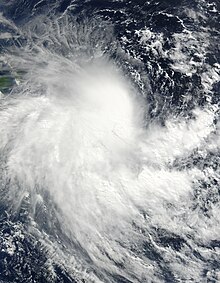 Raquel prior to peak strength on June 30 | |
| Meteorological history | |
|---|---|
| Formed | June 28, 2015 |
| Dissipated | July 5, 2015 |
| Category 1 tropical cyclone | |
| 10-minute sustained (BOM) | |
| Highest winds | 65 km/h (40 mph) |
| Lowest pressure | 996 hPa (mbar); 29.41 inHg |
| Tropical storm | |
| 1-minute sustained (SSHWS/JTWC) | |
| Highest winds | 85 km/h (50 mph) |
| Lowest pressure | 989 hPa (mbar); 29.21 inHg |
| Overall effects | |
| Fatalities | 1 direct |
| Missing | 8 |
| Damage | Minimal |
| Areas affected | Solomon Islands |
| IBTrACS | |
Part of the 2014–15 South Pacific cyclone season and 2014–15 Australian region cyclone season | |
Tropical Cyclone Raquel was the first tropical cyclone to exist within the South Pacific Ocean during the month of July on record. The system was first noted during June 28, 2015, while it was located to the northeast of Honiara in the Solomon Islands within the South Pacific basin. Over the next few days the system moved south-westwards towards the Solomon Islands, under the influence of a ridge of high pressure and gradually developed further. The system was subsequently named Raquel during June 30, as it moved into the Australian region and developed into a Category 1 tropical cyclone on the Australian tropical cyclone intensity scale. Strong vertical wind shear subsequently limited further development of the system, with atmospheric convection surrounding the system displaced to the west and south of the system. The system subsequently weakened into a tropical depression during July 2, after it had recurved and move eastwards into the South Pacific basin. During that day atmospheric convection surrounding the system improved, as it started to move towards the south-southwest and the Australian region. Raquel subsequently passed near or over several of the Solomon Islands between July 3–5, before it was last noted to the south-west of Guadalcanal during July 5, as it rapidly lost its tropical characteristics.
Raquel brought major flooding to the Solomon Islands where significant damage took place; including a large amount of agricultural damage and structural damage to hundreds of homes.